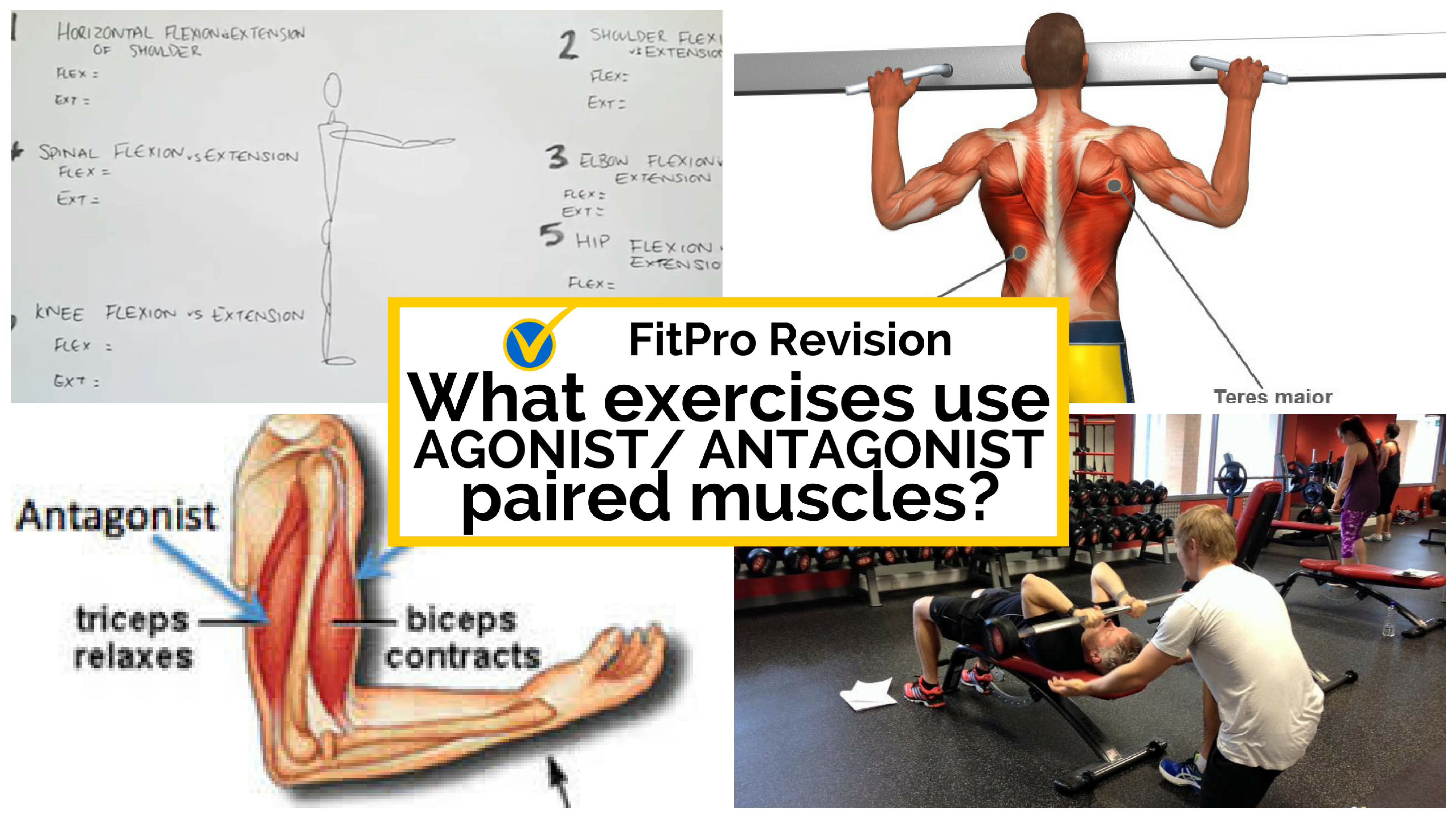This blog will teach you all about Agonist Antagonist paired muscles for your L2 Anatomy exam and knowledge when planning supersets for clients.
You’ll discover:
- Why do you need to know about Agonist antagonist paired muscles?
- What is reciprocal inhibition?
- 12 Minute video tutorial about paired muscles
- Summary of 6 Joint Action pairings
- Mock Questions to test your knowledge ready for the exam
- A simple way to learn EVERYTHING for your exam in 8 hours
Why do you need to know about Agonist antagonist paired muscles?
The principle that muscles “work in pairs” is taught at Level 2 Anatomy and Physiology. You need to know about key muscle pairings and how they work together through Recipricol Inhibition. This blog will teach you both of these so you can be ready for your anatomy exam.
When you are designing supersets for your clients, you need to know what exercises use agonist antagonist paired muscles.
The best way to start learning this is with the 6 main joint action pairings and then practice exercises that use these joint actions. The 6 joint actions are highlighted in the video tutorial and below in the notes.
What is reciprocal inhibition?
Reciprocal inhibition describes the relaxation of muscles on one side of a joint to accommodate contraction on the other side.
Muscles work in pairs, whilst one works (contracts) the other relaxes. This is kinda like a conversation,
whilst one person is talking, the other person listens. It doesn’t work if both people are trying to talk at the same time.
To understand this, consider the Bicep Curl exercise:
The Prime Mover (or Agonist) is the Biceps Brachii.
When concentrically contracting (getting shorter) the Biceps Brachii creates Elbow flexion.
In order to allow this elbow flexion the Triceps Brachii (antagonist) has to relax.
The Biceps Brachii and Triceps Brachii are agonist antagonist paird muscles
So when we are analyzing a triceps extension exercise, the Triceps Brachii is the Prime mover (Agonist) that contracts, and the Biceps Brachii become the antagonist that relaxes.
This video will give you an easy system for learning the opposite muscle pairs, and planning supersets, that use agonist-antagonist paired muscles.
12 Minute video tutorial: Agonist Antagonist Paired Muscles
In the video, you learn about 6 key joint actions and the main muscle prime mover responsible for each action. Knowing this will help consolidate what you learned for your Level 2 or 3 anatomy and physiology exam, and it will also help you relate anatomy to planning.
This knowledge is key in helping you understand WHY you are programming certain exercises for your client based on the client’s goal and physiology.
The 6 key joint actions for effective agonist-antagonist supersetting:
Pair 1:
Shoulder Horizontal Flexion (Working the Pectoralis Major) and
Shoulder Horizontal Extension (Working Trapezius and the Rhomboids)
These are Horizontal push and pull exercises; A superset example is Bench Press into Seated Row
Pair 2:
Shoulder Flexion (working the Deltoid) and
Shoulder Extension (working the Latissimus Dorsi) for .
These are Vertical push and pull exercises; A superset example is Shoulder Press into Lat Pull Down.
Pair 3:
Elbow Flexion (working the biceps brachii) and
Elbow Extension (working the triceps brachii)
An example agonist-antagonist superset would be cable biceps curl into cable overhead extension.
Pair 4:
Spinal Flexion (working the Rectus Abdominus) and
Spinal Extension (working the Erector Spinae)
An example superset would be Ab Crunch into Back Raise
Pair 5:
Hip Flexion (woking the hip flexors -iliopsoas) and
Hip Extension (working the glutes)
A superset example would be hanging leg-raises into kettlebell swing
Pair 6:
Knee Flexion (working the Hamstrings) and
Knee Extension (working the Quadriceps)
A superset example would be a leg curl machine into an extension machine.
Agonist-Antagonist Pairs – Mock Questions
Test your knowledge by answering these three mock questions: answers are at the bottom of the blog.
Q1: Which of the following is the antagonist if Biceps Brachii is the agonist?
A. Triceps Brachii
B. Rectus Femoris
C. Biceps Femoris
D. Brachioradialis
Q2: According to the rule of Recipricol Inhibition, what happens to the antagonistic muscle when agonist concentrically contracts?
A. Eccentric Contraction
B. Concentric Contraction
C. Relax and lengthen
D. Relax and shorten
Q3: What would be a suitable agonist-antagonist pairing if the Shoulder Press was the first exercise?
A. Biceps Curl
B. Lat Pull Down
C. Leg Extension
D. Seated Row
ANSWERS
Q1 = A
Q2 = C
Q3 = B
If you want more mock questions like this, then you can download more Free Mock Questions: DOWNLOAD NOW
Need More Help with your Level 2 Anatomy Revision?
For Trainee FITPROS Taking Their L2 Anatomy & Physiology Exam.
Learn, Revise & Pass Your Level 2 Anatomy & Physiology Exam In Under 10-hours
(Without Having To Spend Hours Revising Or Feeling Overwhelmed)
If you want to get your revision structured, learn everything you need to know and feel confident on exam day, then click the link below:
https://courses.parallelcoaching.co.uk/products/level-2-anatomy-and-physiology-revision-bootcamp

Dedicated to More
Hayley “What exercises use agonist antagonist paired muscles?” Bergman
Parallel Coaching
P.S. You can also find us on the following platforms:
Instagram: Follow Now
Facebook: Like Our Page
Twitter: Tweet Us
YouTube: Subscribe Here
More Muscles Blogs: HERE

